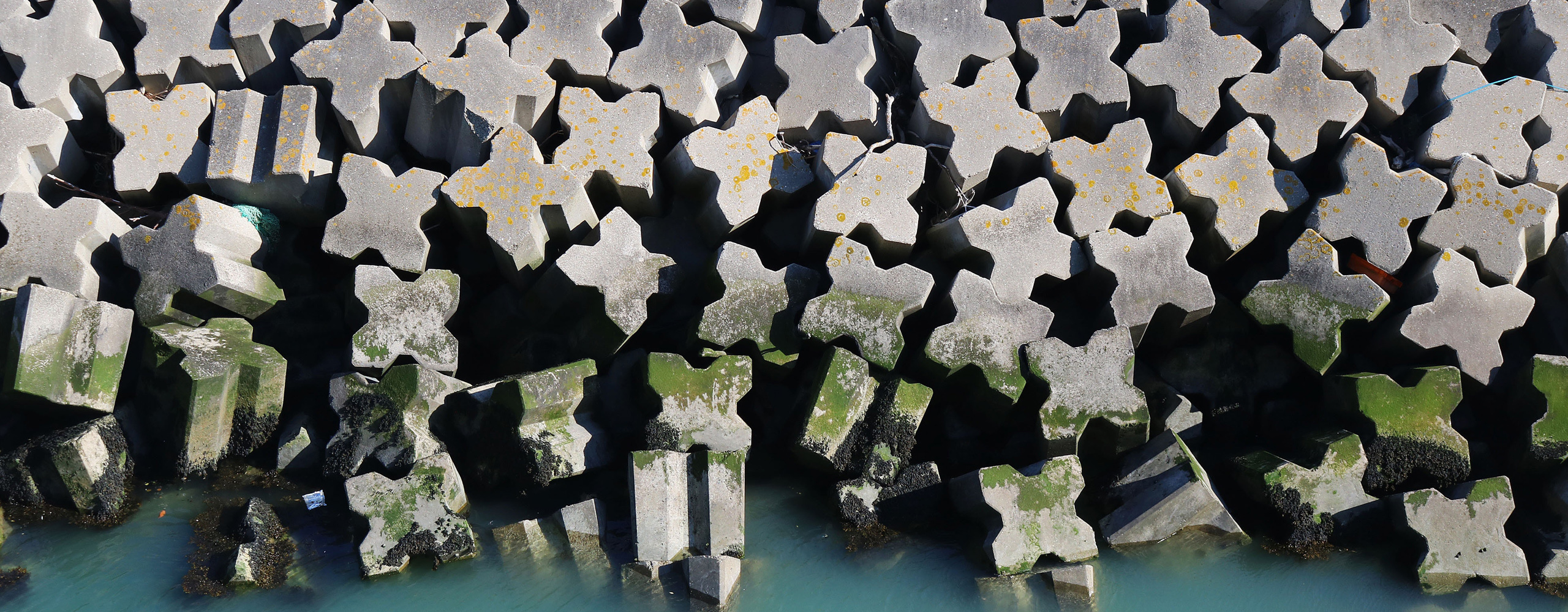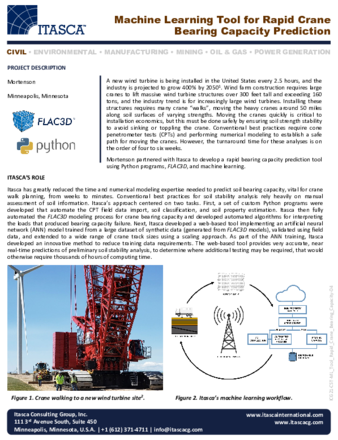
Machine Learning Tool for Rapid Crane Bearing Capacity Prediction (2021)
Wind farm construction requires large cranes to lift massive wind turbine structures over 300 feet tall and exceeding 160 tons. Installing these structures requires many crane “walks”, moving the heavy cranes around 50 miles along soil surfaces of varying strengths. Moving the cranes quickly is critical to installation economics, but this must be done safely by ensuring soil strength stability to avoid sinking or toppling the crane. Conventional best practices require cone penetrometer tests (CPTs) and performing numerical modeling to establish a safe path for moving the cranes requires on the order of four to six weeks. Itasca developed a rapid bearing capacity prediction tool using Python scripts, FLAC3D, and machine learning to provide near real-time feedback on the soil bearing capacity at a location, allowing enhanced crane walk planning.

Effective elastic properties of fractured rocks (2021)
The objective of the project is to predict the scaling evolution of rock mass effective elastic properties for conditions relevant to the POSE (Posiva’s Olkiluoto Spalling Experiment) niche surroundings at ONKALO, the Finnish site for underground storage of nuclear waste.
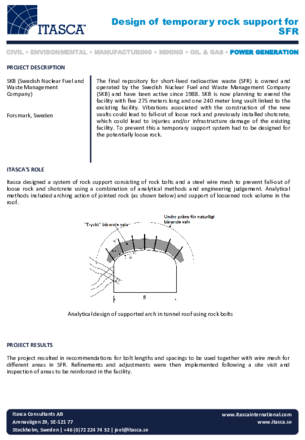
Design of temporary rock support for SFR (2021)
The Swedish Nuclear Fuel and Waste Management Company (SKB) is planning to extend the short-lived radioactive waste repository with five 275 meters long and one 240 meter long vault. Since the extension could lead to damage on the existing facility, Itasca designed a temporary support system to prevent loose rock.
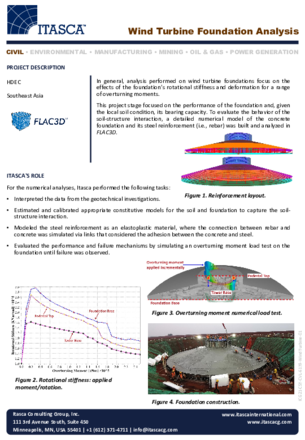
Wind Turbine Foundation Analysis (2021)
In general, analysis performed on wind turbine foundations focus on the effects of the foundation’s rotational stiffness and deformation for a range of overturning moments. This project stage focused on the performance of the foundation and, given the local soil condition, its bearing capacity. To evaluate the behavior of the soil-structure interaction, a detailed numerical model of the concrete foundation and its steel reinforcement (i.e., rebar) was built and analyzed in FLAC3D.
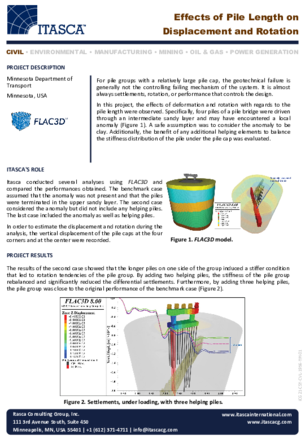
Effects of Pile Length on Displacement and Rotation (2021)
In this project, the effects of deformation and rotation with regards to the pile length were observed. Specifically, four piles of a pile bridge were driven through an intermediate sandy layer and may have encountered a local anomaly (Figure 1). A safe assumption was to consider the anomaly to be clay. Additionally, the benefit of any additional helping elements to balance the stiffness distribution of the pile under the pile cap was evaluated.

Modeling of Spalling in PFC3D — A Quantitative Assessment (2020)
SKB is interested in developing a 3D discrete model to predict spalling on the excavation boundaries of underground repositories for the long-term storage of spent nuclear fuel. This project provided a quantitative assessment of modeling spalling using PFC3D to study both lab- and tunnel-scale behavior.

Stability Design of Open Pit Walls Using 3D Modelling Approach (2020)
The open pit mine is part of a Greenfield exploration project. Itasca Consultants GmbH in corporation with Itasca Chile were contracted to develop a stability design of the pit. The analysis has been performed using Itasca’s three-dimensional distinct element code, 3DEC (Itasca, 2016).

Influence of former near-surface ore mining on a road construction project (2020)
The road construction department of district Steinfurt, a district in the north of the coal mining area in the Ruhr region, is planning the construction of the new road K 24n. The road axis runs through an area partly affected by old mining operations. These mining operations took place between 1880 and 1921.

Rock mechanical analyses for the Boliden deep repository at Rönnskär (2020)
Boliden AB is constructing an underground repository for final storage of process waste material from the Rönnskär copper smelter facility. The repository is excavated at a depth of 330 m and the main components are storage rooms with a vertical footprint of 16 by 18 m and with lengths varying between 50 and about 200 m. Itasca was contracted by Boliden to carry out rock mechanical analysis to assess the stability in both the short- and long-term (3000 years) perspectives. FLAC3D and 3DEC models were used to study global and local stability as well as the potential for long term effects on flow paths in the rock mass resulting from the excavation of the repository.

Conditioning DFN models by GPR data (2020)
As part of the EU Horizon 2020 ENIGMA ITN project, ICSAS, the CNRS, and SKB proposed a PhD project entitled “Flow and transport in fracture networks: reducing uncertainty of DFN models by conditioning to geology and geophysical data”, to develop and test a methodology for rock characterization that would help in the decision-making process for an adequate location of the nuclear waste canister burying.

Interaction of old near surface coal mining and a road construction project (2020)
The new connecting road K 24n is to be built in the most northern expanses of the coal mining area in the Ruhr region. The road axis runs through an area partly affected by old surface near mining operations. The coal is located in two seams, both dipping north with an angle of approx. 11°. These seams have been mined by three potential drifts, which have been identified by a geophysical field study.

Caving Propagation Study for the Esmeralda Block 1 (2020)
With the transition from Open Pit to Block Cave mining at the Chuquicamata Underground Project, it was necessary to validate ITASCA´s caving algorithm (IMASS) as used to predict caveability in a structurally controlled environment. CODELCO proposed a case study at Esmeralda Mine, El Teniente Division, which was known to have been influenced by the presence of a few major faults in its development.

Numerical calculations for the pre-dimensioning of the support lining in a ventilation shaft (2020)
A ventilation shaft in Germany is part of a former colliery and was put into operation in the late 19th century with a depth of approx. 600 m. Since the colliery was closed down, it has been part of the central water drainage system at the site, together with further shafts in the near distance. In the course of technical reconstruction measures, the shaft is to be converted from a ventilation shaft to a well shaft. For this purpose, the current diameter has to be expanded to a clearance of 3.3 m. The shaft, which was previously constructed with approx. 50 cm thick brick masonry, will be secured with a concrete shell after expansion. To evaluate the predimensioning of the shell, a numerical modeling of the secondary stress field is necessary.

Simulating Spalling With a Flat-Jointed Material (2020)
Long-term storage of spent fuel is critical to the nuclear energy industry. The Swedish Nuclear Fuel and Waste Management Company (SKB) is developing an approach for the storage of spent nuclear fuel in an underground repository in competent crystalline rock. In order to better understand the spalling damage process, an in-situ test involving the drilling of two boreholes was performed in Äspö diorite at SKB’s underground hard rock laboratory in Äspö. Tests and monitoring were performed on the pillar that separated the boreholes. In order to further investigate the damage process, Itasca performed numerical modeling using PFC3D and FLAC3D.

Numerical simulations of shield support for a coal mine (2019)
The development and mining of a deeper seam in a coal mine, located in southern Siberia is planned. ITASCA was tasked with assessing the minimum support pressure and maximum unsupported distance between shield and coal face required to ensure stability of the roof. Also the stress state, displacement field and excavation damaged zone in the roof of the seam were analyzed.
